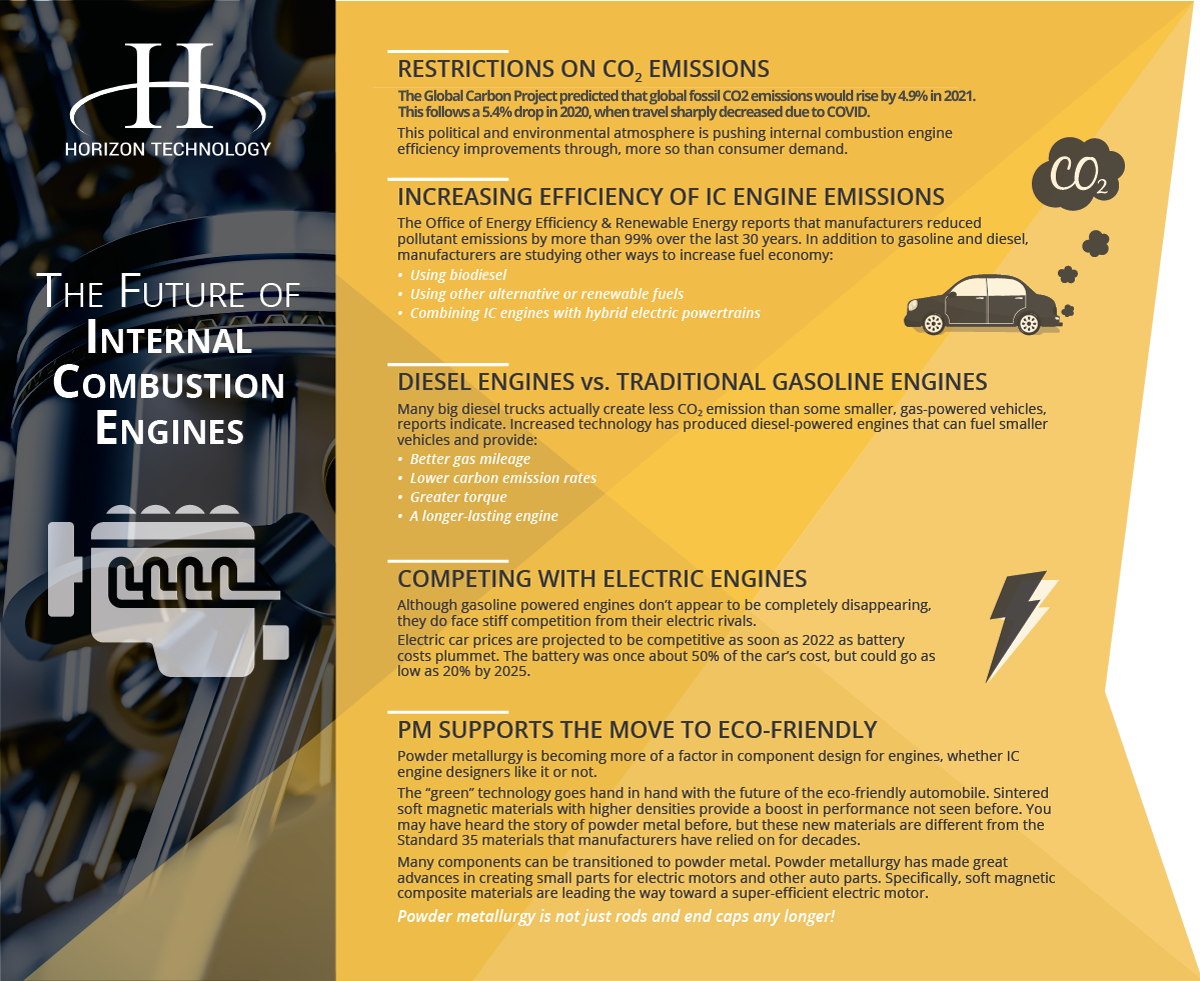The invention of the internal combustion (IC) engine was a boon to transportation and efficiency and all things America. But, as IC technology ages and environmental concerns increase, alternatives are looking to take its place.
Automakers and consumers alike are mulling the future of internal combustion engine car and truck production, and looking at what will replace current designs. Reviewing what got us here, as well as new efficiency and environmental challenges that powder metal could help solve, are lessons no OEM engineer should miss:
The Future of Internal Combustion Engine Design
Look for these outside factors to influence how engineers approach internal combustion engine design over the next decade:
- CO₂ emissions restrictions
- Engine efficiency for reducing those emissions
- Diesel vs. traditional gas
- EVs vs. ICE vehicles
- Powder metallurgy supporting the move to eco-friendly
Open the image in a new tab to see a full-scale version of this infographic:

1. Restrictions on CO₂ Emissions
The Global Carbon Project reported that worldwide carbon dioxide emissions were expected to rise by 4.9% in 2021, nearly back to their record 2019 levels. Emissions plummeted from 2019 to 2020 (5.4%) as the COVID pandemic brought travel to a near-standstill.
In August 2021, the U.S. Environmental Protection Agency (EPA) proposed revised Greenhouse Gas Emissions guidelines for passenger cars and trucks in model years 2023-2026. The proposed standards include 10% greater emissions improvement than current standards for MY 2023 vehicles and 5% greater emissions improvement in each of the following 3 years. Current standards only become 1.5% more stringent each year.
At the same time, EPA announced plans to reduce pollutants from heavy-duty trucks through stricter rules. The agency expects the new rules will apply to heavy-duty vehicles beginning in MY 2027.
Regardless of the EPA's plans, the political and environmental atmosphere is still pushing internal combustion engine efficiency improvements more than consumer demand is. Whether engineers and executives personally agree or not with the changes in the air, the industry is moving steadily in that direction.
2. How to Increase Efficiency of IC Engine Emissions?
The Office of Energy Efficiency & Renewable Energy reports that manufacturers reduced pollutant emissions by more than 99% over a 30-year span. Creative minds accomplished this while maintaining or increasing fuel economy.
In addition to gasoline and diesel, manufacturers are studying other ways to increase fuel economy:
- Using biodiesel
- Using other alternative or renewable fuels
- Combining IC engines with hybrid electric powertrains
3. Diesel Engines vs. Traditional Gasoline Engines
When Europeans switched from diesel to gasoline cars, there was a related increase in carbon dioxide emissions. In an unexpected twist, some of today’s auto strategies are based around diesel engines.
Many big diesel trucks actually create less CO2 emission than some smaller, gas-powered vehicles, reports indicate. Increased technology has produced diesel-powered engines that can fuel smaller vehicles and provide:
- Better gas mileage
- Lower carbon emission rates
- Greater torque
- A longer-lasting engine
A 2021 University of Michigan study (alongside General Motors) claimed that in consumer vehicles, 100% renewable diesel can reduce carbon emissions. Participating engineers said the renewable hydrocarbon biofuel reduced carbon footprint by 80% over traditional petroleum fuels in the Chevy Cruze and GMC Sierra diesels they tested.
Perhaps diesel is a capable fill-in while some parts of the world (like the U.S.) catch on to buying electric vehicles?
4. Battery Electric Vehicles vs. Internal Combustion Engine Vehicles
You knew this was coming. Although gasoline-powered engines don’t appear to be completely disappearing, they do face stiff competition from their electric rivals.
Even BMW, whose board member in charge of development called auto electrification "overhyped" in 2019, is signaling the beginning of the end. In October 2021, BMW announced it would stop making internal combustion engines at one of its plants (in Munich) by 2024. BMW is aiming for 50% of its new-car sales to be electric by 2030,
One thing IC engine supporters could always hang over the heads of the pro-electric crowd was the battery. Specifically, its:
- Size
- Cost
- Longevity
- Charging capabilities, or lack thereof
However, electric vehicles are projected to reach price parity with traditional vehicles by the mid-2022s as EV battery costs plummet. BloombergNEF projected in 2021 that the cost of a lithium-ion EV battery pack will fall below $100 per kWh by 2023, an approximately 20% drop. These reductions are certainly coming more quickly than the market expected.
Concerns about range will be less of an issue for electric vehicles going forward. The technology is evolving, and more charging stations are popping up. “Range anxiety” (consumer fear that they’ll be stranded with nowhere to charge their battery) is still a very real issue OEMs still need to resolve.
5. Powder Metallurgy Supports the Move to Eco-Friendly
Advanced powder metallurgy -- far different from your father's powder metallurgy -- is becoming more of a factor in component design for engines.
The “green” technology that is powder metallurgy goes hand in hand with the future of the eco-friendly automobile. Sintered soft magnetic materials with higher densities are providing a boost in performance not seen before. You may have heard the story of powder metal before, but these new materials are different from the Standard 35 materials that manufacturers have relied on for decades.
MPIF’s Standard 35 is a great baseline for powder metallurgy manufacturers, but your future stator and rotor designs may need materials and processes that surpass “standard” performance levels. In some cases you can even eliminate a component from the assembly by designing with powder metal.
Today’s advanced compaction technology may be a little more expensive at the onset, but it can save manufacturers (and drivers) a lot in the long run.
Many components can be transitioned to powder metal. Powder metallurgy has made great advances in creating small parts for electric motors and other auto parts for many reasons:
- Reduces weight
- Improves electric motor efficiency, including better magnetic properties
- Creates net-shape parts
- Allows for advanced materials and processes
- Higher strength and hardness
Specifically, soft magnetic composite materials are leading the way toward a super-efficient electric motor.
Powder metallurgy is not just rods and end caps any longer!
Where Will You Turn Next?
Today’s powder metallurgy services allow for a smooth transition from the traditional internal combustion engine design to the more efficient and environmentally conscious engines of the future. Advances in PM materials (like you'll find below) and processes (like sintering) have made that possible.
Of course, IC engines will still be around for a while. Powder metallurgy can facilitate new or alternative internal combustion engine designs too.
To see how you can use new powder metallurgy materials and processes to upgrade your motor's design and performance, check out our Resource Hub:
Related Resources
- Automotive Powertrain Design's Past + Future: EVs, Hybrids, IC, Diesel
- Automotive Powertrain Design: Torque + 3 Other Considerations & Trends
- 3 Trends in Manufacturing Auto Parts: Does Powder Metal Have a Place?
(Editor's note: This article was originally published in September 2019 and was recently updated.)


